Seating Arrangements
Seating Arrangements:
In these questions, you have to arrange a group of persons fulfilling certain conditions. This is also written as sitting arrangement or sitting arrangement reasoning at some places. Here we can classify these problems into 4 types:
1. Linear Arrangement: Here the arrangement of the persons is linear i.e. you have to arrange them in a line. Here generally a single row of arrangement is formed.
2. Double row arrangement: In these questions, there will be two groups of persons. You have to arrange one group in one row and the other group in other row. The persons in these rows normally face each other.
3. Circular arrangement: In the circular seating arrangement questions, you have to arrange the persons around a circular table etc. fulfilling certain conditions.
4. Rectangular arrangement: These arrangements are almost similar to the circular arrangements; the only difference is that the persons are sitting around a rectangular table.
Questions on seating arrangement are generally asked in blocks of 4 – 5 questions. You are given some information and then there will 4 -5 questions based on the information. These questions have two types of information:
1. Direct information: This is the information which is clearly mentioned in the statement of the question. This is the information which you will use when you start solving the questions.
2. Indirect information: After filling the direct information you will look for the connection between different parts of the information. These connections form the indirect information. While arranging the persons, the direction to which the persons are facing is very important.
Linear Sitting Arrangement
In a linear seating arrangement, persons are sitting in a line or row facing north or south direction. Here also some conditions are given on the basis of which we have to get our required answer

Double Row Sitting Arrangement
In double row arrangement, then one group of people will be facing north and the second will face south and the directions will be taken as similar to the above figure
Circular Sitting Arrangement
Circular seating arrangement is a part seating arrangements where people are seated around a circular or square or polygonal table .There are, primarily three types of questions under circular arrangements.
- Circular arrangement with people facing center of a table.
- Circular arrangement with people facing outward of a table.
- Circular arrangement with some people facing center of a table where as some people facing outward.
Let us see how to solve the first type of circular arrangement problems i.e. circular arrangements with people facing the center of a table.
How to Solve Circular Arrangement-Type I
Here are a few tips to remember:
- Imagine yourself as one of the persons given in the question.
- Count how many people are mentioned in the question. Then draw a circle with those many lines.For e.g. If in the question, assume that it is given that there are eight friends A, B, C, D, E, F, and H sitting around a circle facing the center. Then you can draw a circle as shown below in fig .
Imagine yourself at the position shown by the box.
- Now your left hand is the left side and right hand is the right side.
- Now if in question it is given, A is third to the right of B, approach as follows.
- Imagine yourself as B.
- Place B at position shown in fig
- Now A is third to the right of B. The right of B is your right side. So place A three places from B towards its right. This can be seen in fig 3.

Now for left side of A we use clockwise rotation. And for right side of A we use anticlockwise rotation. So we can say that B is third to the left of A. Refer fig 4.
The Second type of seating Arrangement is Discussed below.
If the persons are looking away from the center then the right hand side will be in the clockwise direction and left hand side will be in the anti clockwise direction
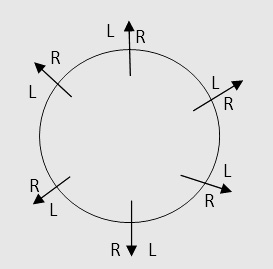
Similarly in type 3 objects facing inwards obey the respective rules and objects facing outwards obey their rules respectively.
Circular Arrangement Example:
Eight people P, Q, R, S, T, U, V and W, are seated around a circular table facing each other. R is second to the right of P and third to the left of Q. Q is second to the left of V. S and V are diagonally opposite to each other. U is a neighbor of S. T is third to the left of W.
Step I: Read the whole information once.
Step II: Count the number of people given and draw the circle accordingly. Now in the question 8 people are mentioned. So draw a circle with 8 lines facing inside.
Step III: Indicate Left and Right sides with arrows with respect to bottom-most position.
Step IV: Try to get direct information. Imagine yourself as one of them and star plotting them with respect to you.
Now in question it is given that,
1) R is second to right of P and third to left of Q. So imagine yourself as P and place yourself in the lowermost position as shown before.

2) R is second to the right of P. So place R, second towards your right hand side.

3) Now it is also given that R is third to left of Q. i.e. Q is third to right of R. So place Q accordingly.

4) Q is second to left of V. i.e. V is second to right of Q. So now place V second place from Q in anticlockwise direction.
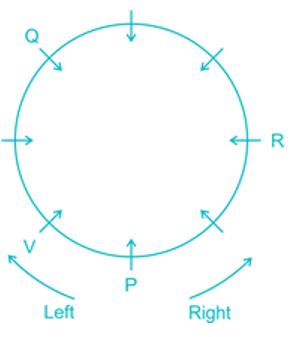
5) S and V are diagonally opposite to each other. So that means S and V are exactly facing each other i.e. are diametrically opposite.

6) U is a neighbour of S. Now on one side of S, we already have R. So U must take the only available place next to S.
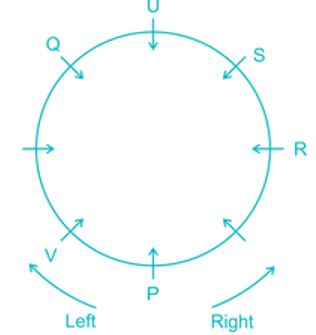
7) Finally T is third to left of W. We have only two positions left. This condition is only possible when W is placed between P and R.
So the final arrangement will be as shown below.
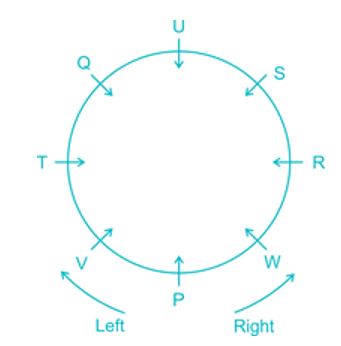
Rectangular Sitting Arrangement
This particular seating arrangement is also known as square seating arrangement .As defined these arrangements are almost similar to the circular arrangements; the only difference is that the persons are sitting around a rectangular table. the figure below will help you in to get a clear insight of the rectangular seating arrangement.
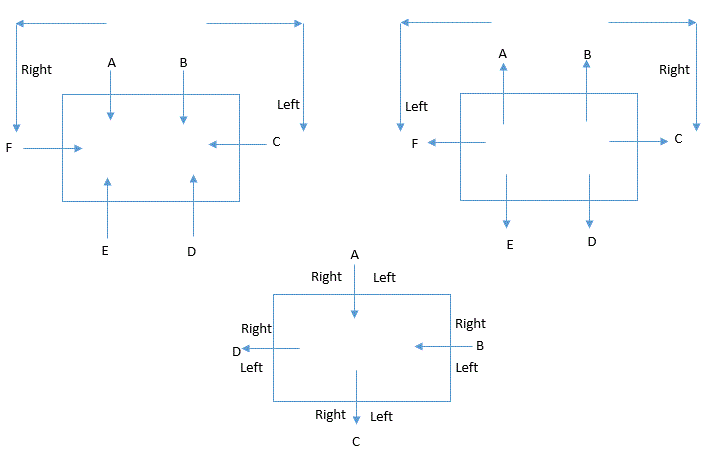
1) A, P, R, X, S u0026amp; Z are sitting in a row. S and Z are in the center. A and P are at the ends. R is sitting to the left of Who is to the right of P ?
Options
A. A B. X C. S D. Z
Answer: Option B
Explanation: The seating arrangement is as follows:

Therefore, right of P is X.2) Six girls are sitting in a circle facing to the centre of the circle. They are P, Q, R, S, T and V. T is not between Q and S but some other one. P is next to the left of V. R is 4th to the right of P. i)Which of the following statement is not true ? A. S is just next to the right to R B. T is just next to the right of V C. R is second to the left of T D. P is second to the right of R
Answer: Option C
Explanation:

ii)If P and R interchange their positions then which of the following pair will sit together ?
Options
A. RT B. PV C. VT D. QV
Answer: Option C
Explanation: After changing the position of P and R
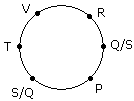
V and T are together.
iii) What is the position of T ?
Options
A. Just next to the right of Q
B. Second to the left of P
C. Between Q and R
D. To the immediate right of V
Answer: Option D
Explanation:

3) 8 persons E, F, G, H, I, J, K and L are seated around a square table – two on each side.
- There are 3 ladies who are not seated next to each other.
- J is between L and F.
- G is between I and F.
- H, a lady member is second to the left of J.
- F, a male member is seated opposite to E, a lady member.
- There is a lady member between F and I.
i) Who among the following is to the immediate left of F ?
A. G B. I C. J D. H
Answer: Option C
Explanation:

ii) What is true about J and K ?
A. J is male, K is female
B. J is female, K is male
C. Both are female
D. Both are male
Answer: Option D
Explanation:

Both are male.
iii)How many persons are seated between K and F ?
Options
A. 1 B. 2 C. 3 D. 4
Answer: Option C
Explanation:

Three persons are seated between K and F(H, L and J) or E, I and G.
